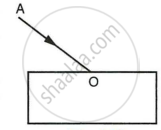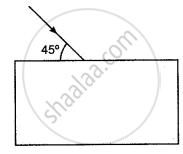Advertisements
Advertisements
Question
In the adjacent diagram, AO is a ray of light incident on a rectangular glass slab.

- Complete the path of the ray till it emerges out of the slab.
- In the diagram, mark the angle of incidence (i) and the angle of refraction (r) at the first interface. How is the refractive index of glass related to the angles i and r?
- Mark angles of emergence by the letter e. How are the angles i and e related?
- Which two rays are parallel to each other? Name them.
- Indicate in the diagram the lateral displacement between the emergent ray and the incident ray. State one factor that affects the lateral displacement.
Solution
- The ray's path through the glass slab is complete.
- `""^amu_g = "R.I glass" = sin i/sin r`

- Angle of emergence ∠e is marked ∠i = ∠e
- Emergent ray BD and incident ray AO are parallel.
- DE shows the lateral displacement.
The following factors affect lateral displacement:
- The angle of incidence.
- The glass slab's (or medium's) thickness.
- Refractive index of glass.
APPEARS IN
RELATED QUESTIONS
If the speed of light in vacuum is 3 × 108 ms−1, find the speed of light in a medium of absolute refractive index 1.5.
The speed of light in glass is 2 × 105 km/s. What is the refractive index of glass?
Draw the diagram given below and clearly show the path taken by the emergent ray.

How is the reflection of light ray from a plane mirror different from the refraction of light ray as it enters a block of glass?
How can you bend light away from the normal?
Why do the faces of persons sitting around campfire appear to shimmer?
What is the total reflecting prism?
How does the angle of deviation produced by a prism depend on the colour of light used? Which colour of white light is deviated (i) most, (ii) least, by a prism?
